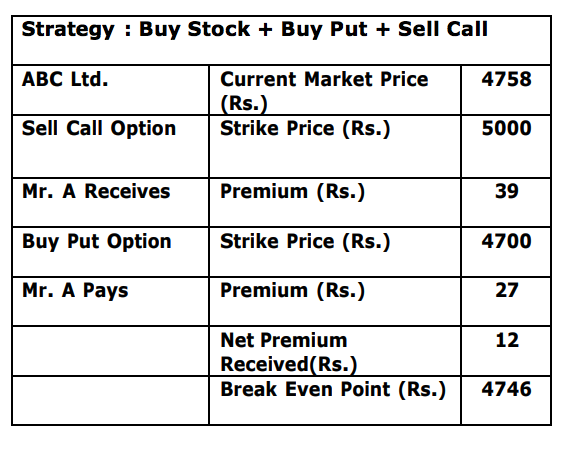A Collar is similar to Covered Call (Strategy 6) but involves another leg – buying a Put to insure against the fall in the price of the stock. It is a Covered Call with a limited risk. So a Collar is buying a stock, insuring against the downside by buying a Put and then financing (partly) the Put by selling a Call.
The put generally is ATM and the call is OTM having the same expiration month and must be equal in number of shares. This is a low risk strategy since the Put prevents downside risk. However, do not expect unlimited rewards since the Call prevents that. It is a strategy to be adopted when the investor is conservatively bullish. The following example should make Collar easier to understand.
When to Use: The collar is a good strategy to use if the investor is writing covered calls to earn premiums but wishes to protect himself from an unexpected sharp drop in the price of the underlying security.
Risk: Limited
Reward: Limited
Breakeven: Purchase Price of Underlying – Call Premium + Put Premium
Example Suppose an investor Mr. A buys or is holding ABC Ltd. currently trading at Rs. 4758. He decides to establish a collar by writing a Call of strike price Rs. 5000 for Rs. 39 while simultaneously purchasing a Rs. 4700 strike price Put for Rs. 27. Since he pays Rs. 4758 for the stock ABC Ltd., another Rs. 27 for the Put but receives Rs. 39 for selling the Call option, his total investment is Rs. 4746.

Example :
1) If the price of ABC Ltd. rises to Rs. 5100 after a month, then,
a. Mr. A will sell the stock at Rs. 5100 earning him a profit of Rs. 342 (Rs. 5100 – Rs. 4758)
b. Mr. A will get exercised on the Call he sold and will have to pay Rs. 100.
c . The Put will expire worthless.
d. Net premium received for the Collar is Rs. 12 e. Adding (a + b + d) = Rs. 342 -100 – 12 = Rs. 254
This is the maximum return on the Collar Strategy.
However, unlike a Covered Call, the downside risk here is also limited :
2) If the price of ABC Ltd. falls to Rs. 4400 after a month, then,
a. Mr. A loses Rs. 358 on the stock ABC Ltd.
b. The Call expires worthless
c . The Put can be exercised by Mr. A and he will earn Rs. 300
d. Net premium received for the Collar is Rs. 12
e. Adding (a + b + d) = – Rs. 358 + 300 +12 = – Rs. 46
This is the maximum the investor can loose on the Collar Strategy.
The Upside in this case is much more than the downside risk.

